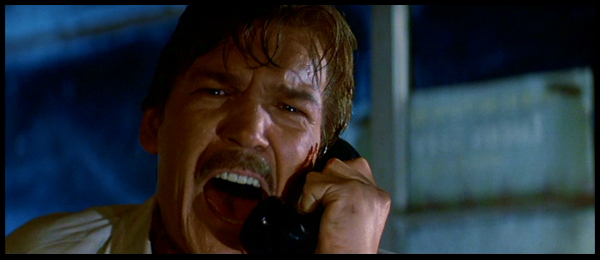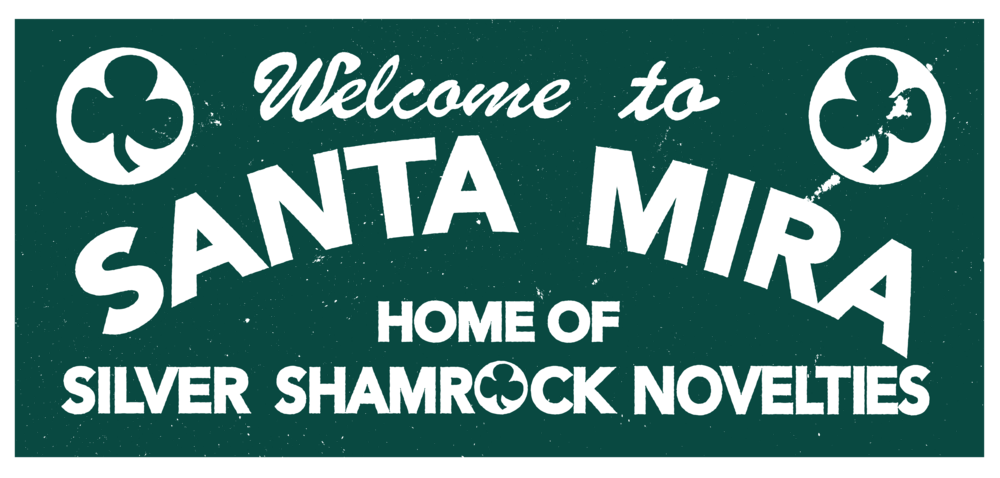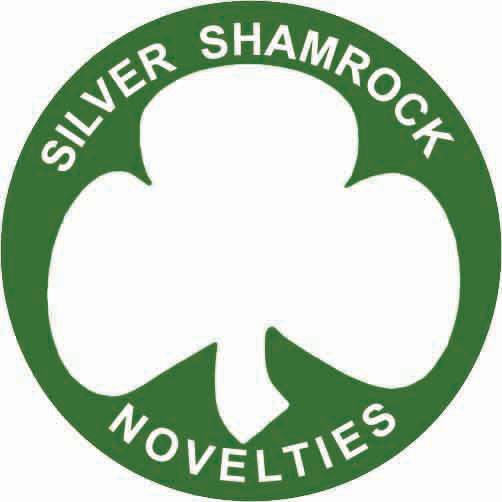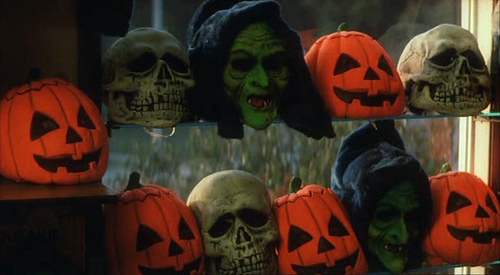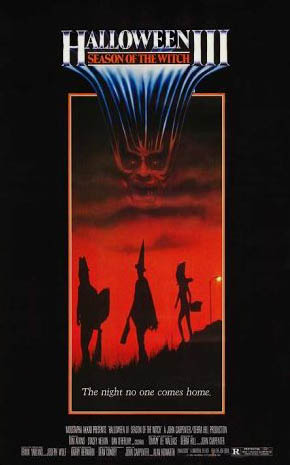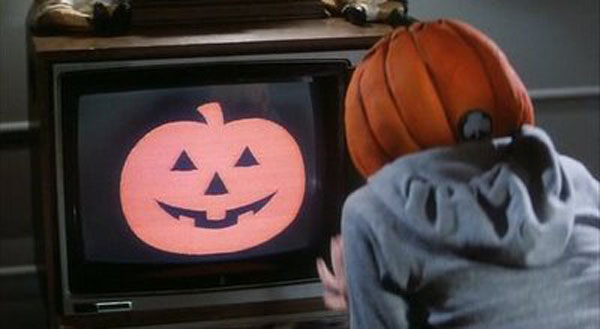John Carpenter was always the first to admit that HALLOWEEN II did not need to exist. He has often told of how he had no interest in directing it because he felt that the story had played itself out to the right conclusion in HALLOWEEN, and ultimately his screenwriting, composing and production duties on the movie represented a pay day above all else. When it came to HALLOWEEN III, the bold – and wise – decision to use the established franchise brand name as a means of trying something fresh failed to reap a satisfying amount of box office cash and earned scorn from fans apparently wanting only a redundant retread of the repetitive Michael Myers shtick rather than something (gasp!) original.
When the series returned in 1988, it was mostly happy to settle back into that predictable, repetitive groove, occasionally throwing in some desperate guff linking Michael to the Druids (!) but otherwise offering the kind of unadventurous rehashing Carpenter was opposed to in the first place.
HALLOWEEN III: SEASON OF THE WITCH is the best of the HALLOWEEN sequels, bar none. Built around an ingenious, marvellously cynical premise from the mind of QUATERMASS auteur Nigel Kneale, it holds up as a fabulous condemnation of the USA’s crass commercialisation of everything (not just Halloween) and as a surprisingly mean-spirited walk on the wild side. No other mainstream American horror film of the 80’s was so enthusiastic about portraying a Typical American Family as an obnoxiously shallow, abrasive unit totally deserving of their gruesome death, and no other American horror film in memory decided to bow out with a cliff-hanger ending implying that the film’s nefarious mastermind Conal Cochran (Dan O’Herlihy) has achieved his mission to wipe out America’s brats en masse via the hijacking of the medium (television) to which they are far too often glued in the absence of any other worthy stimulation. It’s a gruesome picture, it’s inventively bonkers and it isn’t afraid to be mordantly funny. It also has Tom Atkins at his moustache-wearing hunkiest, even if his sex scene with Stacey Nelkin couldn’t be any less erotic if they were both wearing Silver Shamrock masks.
One of the strongest suits of HALLOWEEN III is its original score composed by John Carpenter in association with Alan Howarth. By this time, Carpenter had become renowned as a filmmaker whose self-made distinctive electronic scores were a major part of his films’ effectiveness. Carpenter was consistently modest about his own musical capabilities, often reminding interviewers that he handled musical duties as a means of keeping things simple and cheap. As ASSAULT ON PRECINCT 13, HALLOWEEN, THE FOG and ESCAPE FROM NEW YORK became fan favourites and box office hits it became apparent, however, that they were unimaginable without the Carpenter scores driving the action and ambience. When Carpenter crossed over into the big leagues, he handed scoring duties over to Ennio Morricone for THE THING and Jack Nitszche for STARMAN while also providing the scores for the first two HALLOWEEN sequels to provide an audio continuity with the 1978 original.
Although the soundtrack to HALLOWEEN III employs the same tools of the trade as the much-admired score for HALLOWEEN II (Linn drum machine, Arp sequencer, Prophet synths), it was notable for being the very first score that Carpenter and Howarth improvised, composed and recorded while watching a time-coded tape of the film itself on a monitor, thus creating the music directly in sync to the images unfolding. Carpenter has referred to this process as, alternatively, a “musical electronic colouring book” and, simply, a form of “instant gratification”. Howarth, who enjoyed a high profile start to his film career by working on the STAR TREK movies for Paramount, first worked with Carpenter on ESCAPE FROM NEW YORK, establishing a fruitful relationship throughout the decade that ended with THEY LIVE. In 1988, the year of THEY LIVE’s release, Howarth took over solo scoring duties on the HALLOWEEN sequels, which relied a great deal on variously refined versions and adaptations of Carpenter’s original HALLOWEEN theme. (Note: if the groovy electronic guitar rendition of the theme for HALLOWEEN 6: THE CURSE OF MICHAEL MYERS doesn’t get your foot tapping, you clearly are not worthy of having your own set of ears).
HALLOWEEN III begins, just like its predecessors, with a lengthy fixed shot of a pumpkin. With the change of story direction, this time the pumpkin is in the form of an analog TV signal that, foreshadowing the devastating role television will play in Conal Cochran’s plot, transforms from a static image to an abrasive flickering symbol of doom. From this starting point, the score captures the overall paranoid ambience and theme of the movie perfectly, establishing the sense of electronic threat via the increasingly high pitched, piercing musical stings that gradually overwhelm the ominously pulsing two-note heartbeat underneath.
The score is characterised by slow-building ominousness, with Carpenter working at his most minimalist and the cold analog sound reflecting the soulless robots that are at the core of the film’s plot. The pervasive sense of understated menace occasionally breaks out into outright pulsing terror, perhaps best reflected in the outstanding “Chariots of Pumpkins”, which accompanies the pursuit of Grimbridge in the film’s early chase sequence and sets an insistent, repetitive tinkly motif against a driving, persistent beat. Given how recently the memorably boring British Oscar winner CHARIOTS OF FIRE had made composer Vangelis a household name thanks to his iconic theme, presumably Carpenter and Howarth named the track in wry homage. “First Chase” is similarly persistent and intense, though much of the soundtrack is about capturing a relentless sense of foreboding rather than outright peril.
Carpenter’s scores were characterised in this period by repetition, “stingers” –something he established with HALLOWEEN for the many shock-appearances of the unstoppable Michael Myers – and recurring motifs. HALLOWEEN III makes remarkable use of all of these things while taking the use of dissonance low purring synths to new levels of simmering malevolence. “A Pleasure Doing Business” is particularly evocative as its recurring throb is increasingly dominated by assorted shrill, abrasive elements within an escalating piece overwhelmed by a thumping, terrified heartbeat. On a similar level, “Starker and Marge” is built upon a relentless, shifting six note motif that oozes menace before it’s consumed by a shrill dirge that burns itself out in a suitably uneasy manner.
Some of the cues are uniquely strange and experimental. “Drive To Santa Mira” is more playful and ambiguous in its sense of inexplicable menace, reminiscent of the HALLOWEEN cue “Lights Out”, in which Laurie wanders around night-time Haddonfield, evocative of our heroes encountering the strangeness of Santa Mira for the first time and dominated by a particularly queasy church organ-style sound that makes us uncomfortable in a hard-to-gauge way. “Hello Grandma” is a stand out queue, representing the sequence in which Tom Atkins unwittingly beheads a sweet old lady who turns out to be one of Cochran’s robotic drones. This cue consists of around three minutes of ominousness in the form of a beautifully simple, eerily low key melody increasingly invaded by dissonance.
The score is, of course, punctuated in the movie and in the film’s soundtrack releases by the “Silver Shamrock” jingle, a convincingly obnoxious pastiche of hideous TV ad jingles, designed to invade our brains like an angry tumour just as Silver Shamrock itself literally melts the minds of its young consumers via the TV signal during the “Big Giveaway” at 9pm on Halloween night. Based on “London Bridge Is Falling Down”, this incessant countdown to the big night (“Eight more days to Halloween, Halloween, Halloween, Eight more days to Halloween, Silver Shamrock…” repeat one zillion times) is marvellously malevolent in its own ironically child-friendly way.
Dominated by its deep bass thuds and slow-burning electronic malice, the score for HALLOWEEN III is undoubtedly one of the major highlights of Carpenter’s musical career, and an appropriate conclusion to his involvement in the HALLOWEEN series. THE FOG may have a more melodic eerie beauty and the original HALLOWEEN may be far more immediately recognisable to the majority of viewers, but neither are as inventively unnerving as the soundscape crafted for this exceptional sequel. Amidst the legions of retro-fitted 21st century horror films featuring sinister throwback synth soundtracks, significant movies have been directly inspired by the HALLOWEEN III score, notably 2014’s THE GUEST, which its director narratively considered a combination of THE TERMINATOR and HALLOWEEN while noting how influential SEASON OF THE WITCH was to its audio.
HALLOWEEN III’s soundtrack has enjoyed assorted releases over the years, beginning with MCA’s 12 track original 1982 LP release, which was duplicated for Varese Sarabande’s identical 1989 CD issue. A “Complete Original Score” CD limited to 1000 copies and released by Alan Howarth Incorporated appeared in 2007 and featured 25 tracks, many of which are unique to this release. The most attractive and satisfying release thus far has been the 12 inch vinyl from Death Waltz Records. Death Waltz originally released the score in October 2012 with the original 12-track line-up on a limited edition orange and black vinyl with cover art by Jay Shaw and sleeve notes by Alan Howarth. It’s the October 2014 release, however, that offers the ultimate presentation, incorporating never previously released tracks, a fresh remaster from the original analog tapes and a gorgeous 400 gsm Gatefold sleeve. Unsurprisingly, the soundtrack sounds most at home on vinyl.
The track listing for the Death Waltz release is listed below:
Side A Side B
Halloween III Main Titles (2.35) Silver Shamrock : One More Day (0.48)
Chariots of Pumpkins (3.24) Santa Mira Nightfall (2.01)
Gas Station (0.32) The Rock (3.29)
Robot Kills Grimbridge (3.32) Buddy’s Death (1.34)
Ellie Enters (1.00) Cochran Speaks (1.44)
Microphone (0.53) Silver Shamrock: Happy Happy (0.48)
Drive To Santa Mira (2.29) Challis Escapes (3.36)
Challis and Starker (2.00) South Corridor (4.18)
Marge Revealed (1.18) Titles and Chariots (Alt Mix) 6.18
Silver Shamrock: Two More Days (0.49)
Robots at the Factory (2.04)
First Chase (3.11)
Hello Grandma (2.47)
Article written by Steven West

